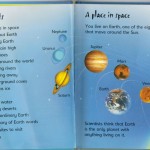My five-year-old son is a recent convert to all things space, owing largely to the superb BBC TV series Wonders of the Solar System, presented by the wonderful Brian Cox. It was directly because of that programme that Joe was able to spot Jupiter’s moon Io immediately from a panel of planets and moons during a recent visit to the Science Museum in London.
The other week we bought Joe a couple of Usborne Beginners books, Sun, Moon and Stars and Planet Earth. He reads them with help, and has them read to him, over and over again. He is confused about one thing though: how many planets are there in the Solar System? Or to be more Joe-like, “What have they done with Pluto??”
When I were a lad, there were nine planets, but of course recently we had to adjust to the notion that Pluto was no longer technically a planet, at least in the same league as the others. I can’t quite get to grips with this concept myself, so to help Joe understand I asked some Facebook friends. The responses I received were brilliant:
“It’s been dubbed a ‘dwarf planet’, probably by some tall person.”
“They decided there are lots of bits of rock the size of Pluto and that therefore it doesn’t deserve the elevated status of ‘planet’.”
“Maybe it was because Holst didn’t write anything for it?”
“Because Pluto is a dog.”
Perhaps the best though was this, from the fabulous Eli Bishop who runs the formidable Riddley Walker Annotations website: “Pluto happened to be discovered first, but isn’t particularly bigger or more interesting than a bunch of other rocks they’ve found since. It didn’t get demoted to an asteroid because it’s big enough to be rounded by gravity and has its own moons, but it’s not big enough to have swept its orbit clean of floating crud, which is part of the current definition of a planet.”
Wikipedia has a summary of the official explanation, but I do prefer Eli’s “floating crud” criterion.
Whatever the truth, technically now there are eight planets. This might not be so bad but for the fact that one of the (identically-packaged) Usborne books that Joe received on the same day says there are nine, while the other says eight. Here are images of the contradictory pages in question:
Of course just because the books look the same, and we ordered them both from Amazon and they arrived at the same time, doesn’t mean they were published at the same time: Sun, Moon and Stars was first published in 2003, while Planet Earth was first published in 2007, after the whole Pluto demotion debacle in 2006. The copyright notice in Sun, Moon and Stars however has been updated (presumably along with the book’s packaging) to say 2003-2007, so you might have thought Usborne would have reviewed the content in 2007 as well. Clearly not.
I think a short letter about this to Usborne is in order…


There are not only eight planets in our solar system, technically or otherwise, and there is absolutely NO reason anyone has to “adjust” to the idea of an eight-planet solar system. Many companies are deliberately keeping Pluto in books and solar system diagrams because of the ongoing controversy over Pluto’s classification. Only four percent of the IAU voted on this, and most are not planetary scientists. Their decision was immediately opposed in a formal petition by hundreds of professional astronomers led by Dr. Alan Stern, Principal Investigator of NASA’s New Horizons mission to Pluto. Stern and like-minded scientists favor a broader planet definition that includes any non-self-luminous spheroidal body in orbit around a star. The spherical part is important because objects become spherical when they attain a state known as hydrostatic equilibrium, meaning they are large enough for their own gravity to pull them into a round shape. This is a characteristic of planets and not of shapeless asteroids and Kuiper Belt Objects. Pluto meets this criterion and is therefore a planet. Under this definition, our solar system has 13 planets: Mercury, Venus, Earth, Mars, Ceres, Jupiter, Saturn, Uranus, Neptune, Pluto, Haumea, Makemake, and Eris.
Pluto is bigger than most rocks in the Kuiper Belt; in fact, it is the tenth largest object orbiting the Sun. Kids can understand the concept that there is a debate regarding its status. Please do your son a favor and make sure he learns the pro-Pluto-as-a-planet viewpoint. I plan to write to Usborne as well urging them to continue putting out solar system books that include Pluto as a planet.
Thanks very much Laurel! Well, Joe gets both viewpoints from his two books, so maybe Usborne have got the balance right 😉
I tweeted at Usborne (@UsbornePR) about this and they replied “in ‘Beginners The Solar System’ which is out in May (and so the most recent) Pluto is described as a ‘dwarf planet'”, adding, “as you mention Sun, Moon and Stars is an older book”. Nice of them to get back to me 🙂